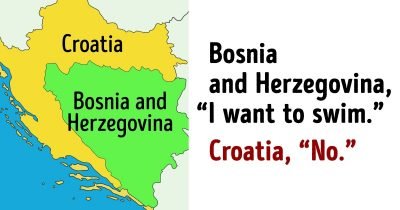Facts
14 Amazing Facts About Our Planet Shared By The National Geographic
The world is filled with mysteries and wonders that have baffled scientists and thinkers for ages, even then life continues to present us with new things to learn every day. Some phenomena are so simple, yet it proves that nature is a system that is chaotic, yet ordered. Some so complex that some scientists have dedicated their whole career lives into studying them.
National Geographic has done its fair share of work in showing us this other strange world that is right before our eyes. These are some quick fun facts that will make you marvel at our planet.
- This is what the top of the Egyptian pyramids look like

This is the Ben-ben stone, (dated to be approximately from 1840B.C.). This stone was discovered in the temple of Phoenix. Egyptians believed that Phoenix was a symbol of cyclical seasons which also had the power to resurrect and create.
This stone was placed on top of Amenemhat III pyramid. The inscription on it is a prayer asking for the pharaoh to “see life again.”
2. If you feed canaries red pepper, they will change their color

The Canaries have a special pigment in their wings that is responsible for their color. This is why the bird’s feathers change into different color tinges depending on the food they eat or due to sun rays. Feeding Canaries with red pepper will turn the color of their feathers orange or completely red. And health-Weise, the red pepper is actually a rich source of vitamins for the birds
3. There used to be a musical composition in the Vatican that was performed once a year and was prohibited from being copied

The Miserere was written by Allegri and used to be performed only once a year in the Vatican by two choirs. The composition was a carefully guarded secret and copying it was highly prohibited. All this happened for 150 years until a 14-year old Mozart heard it once, wrote it down by ear and presented the composition to his sister Nannerl.
When news reached the Vatican, it was very impressed to find out that it was the exact copy. Mozart was awarded the order of the Golden Spur by the Pope himself.
4. There exists a rare and beautiful phenomenon called “Cross sea”.

This is a very beautiful yet rare phenomenon that happens when there are 2 wave systems in the sea moving at oblique angles. Upon the sky, these waves look very beautiful but out on the open sea, they are very dangerous. They can rock and overturn your boat as well as prevent you from reaching offshore.
5. Tutankhamun’s beard fell off during a cleaning process in the Egyptian Museum in 2014.

Pharaoh Tutankhamun’s burial mask is the symbol of Egypt and one of the 10 symbols of our human civilization. The mask, which was discovered in 1922 has survived war and invasions in Egypt until 2014 when workers accidentally knocked off his beard and attempted to glue it back with an epoxy adhesive in order to hide their mistake. This unknowingly, however, brought even more harm to the artifact. The cheat shocked historians all over the world when it was revealed.
6. Some types of orchids are called “devil’s plants” and it’s not for nothing.

The devil’s orchid is a plant native to the forests of Colombia. This recently discovered is unique because of its appearance — you can see the image of a face with horns and red eyes resembling a devil in the middle of the flower. Unfortunately, this plant is not available for the general public because it’s listed as an endangered species and only grows in special conditions.
7. There exists a colorless rainbow that appears under certain conditions.

A white rainbow is a very rare phenomenon that appears during fog and can be seen only when there are very small drops with the radius up to 0.05 mm.
You can see it if you stand with your back to the sun and look toward the fog. Interestingly enough, it can even appear at night when the moon in the sky is quite bright. It, however, has a different name, moonbow.
8. GPS is free for the whole world but expenses for it are $2 million per day.

The global positioning system (GPS), operates worldwide with the help of 24 satellites. The US government, however, spends $750 million per year or about $2 million per day just to maintain the satellites.
According to the government, although the system doesn’t accrue any profits, it could be of great help in avoiding disasters and sending help during emergency situations.
9. If you are from Russia, you could live in different cities not moving anywhere.

You could be born in Petersburg, go to school in Petrograd, and grow old in Saint Petersburg and not move anywhere. Some Russian cities have their names swapped so often that it is easy to get confused about what to call the city you are in.
10. Penguin poo can change the ecosystem of Antarctica.

Penguins have produced more than 17 million pounds of rich nutrients for the plants in Antarctica within the last 5,000 years
If the climate changes, these elements will help plants to cover frozen soil as well as help other members of the ecosystem.
11. Avocados are poisonous for birds, cats, dogs, rabbits, and other pets.

Strange enough avocados are a delicacy to humans but poisonous to every other animal. Avocado leaves contain a poisonous acid called persin, which causes necrosis of the heart muscle and mammary gland in various animal species.
A ground avocado seed can easily kill poultry, while its pulp has enough toxin to down a horse or a cow.
12. Iceland has a tradition of baking bread right in the ground.

Iceland has many active volcanoes and geysers. The native population has learned to harness these features to benefit their daily lives.
One of the oldest recipes for baking “volcano bread” is used even today. A pot with the dough is placed into a hole dug in the soil near a geyser for 24 hours and stone is put on the top of the mound. The temperatures of the soil are known to be as high as 220 degrees Celsius. Enough to bake the bread which is often eaten with butter to neutralize the sulfur taste.
13. In 2016, thousands of giant ice balls appeared along the shore on the Yamal Peninsula in Western Siberia

The experts at the Arctic and Antarctic Research Institute (AARI) say that this is a very rare phenomenon that happens when strong winds carry along with the snow and roll it into balls. The ice balls are polished during motion and collect onto the shore when winds subside
14. Every 23,000 years the Sahara turns from a thick forest into a desert and vice versa.

Scientists say that only 6,000 years ago, the Sahara was covered with green pastures, grass, and trees but climate change has turned the plush terrain into a dusty desert and this will most likely be the case for the next 17,000 years. According to the study, the Sahara undergoes this cycle every 23,000 years.




















